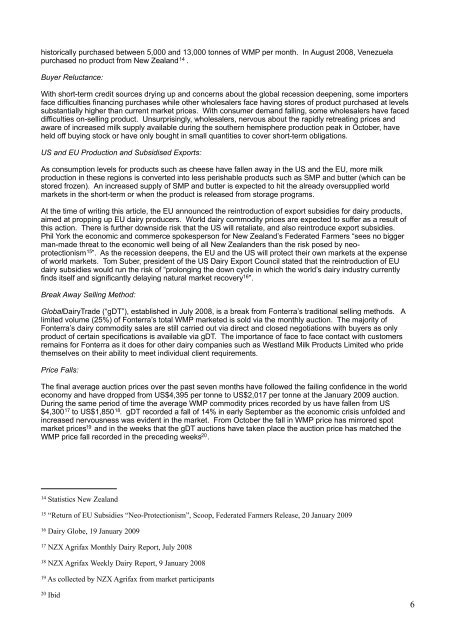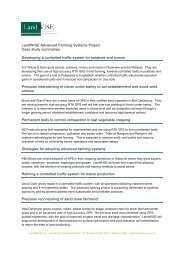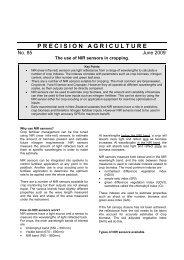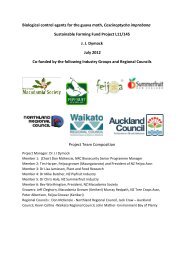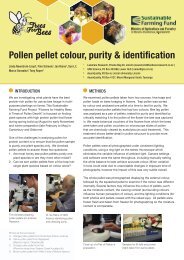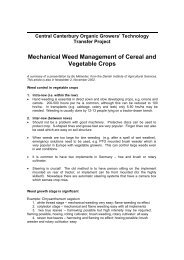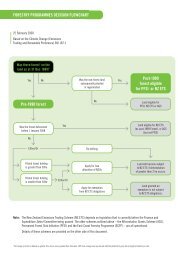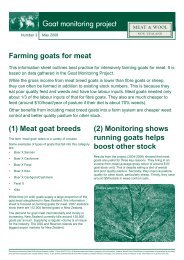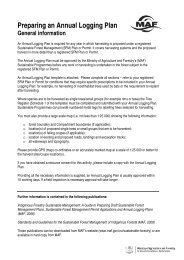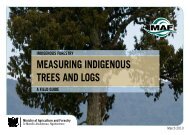Create successful ePaper yourself
Turn your PDF publications into a flip-book with our unique Google optimized e-Paper software.
historically purchased between 5,000 and 13,000 tonnes of WMP per month. In August 2008, Venezuela<br />
purchased no product from New Zealand 14 .<br />
Buyer Reluctance:<br />
With short-term credit sources drying up and concerns about the global recession deepening, some importers<br />
face difficulties financing purchases while other wholesalers face having stores of product purchased at levels<br />
substantially higher than current market prices. With consumer demand falling, some wholesalers have faced<br />
difficulties on-selling product. Unsurprisingly, wholesalers, nervous about the rapidly retreating prices and<br />
aware of increased milk supply available during the southern hemisphere production peak in October, have<br />
held off buying stock or have only bought in small quantities to cover short-term obligations.<br />
US and EU Production and Subsidised Exports:<br />
As consumption levels for products such as cheese have fallen away in the US and the EU, more milk<br />
production in these regions is converted into less perishable products such as SMP and butter (which can be<br />
stored frozen). An increased supply of SMP and butter is expected to hit the already oversupplied world<br />
markets in the short-term or when the product is released from storage programs.<br />
At the time of writing this article, the EU announced the reintroduction of export subsidies for dairy products,<br />
aimed at propping up EU dairy producers. World dairy commodity prices are expected to suffer as a result of<br />
this action. There is further downside risk that the US will retaliate, and also reintroduce export subsidies.<br />
Phil York the economic and commerce spokesperson for New Zealand’s Federated Farmers “sees no bigger<br />
man-made threat to the economic well being of all New Zealanders than the risk posed by neoprotectionism<br />
15 ”. As the recession deepens, the EU and the US will protect their own markets at the expense<br />
of world markets. Tom Suber, president of the US Dairy Export Council stated that the reintroduction of EU<br />
dairy subsidies would run the risk of “prolonging the down cycle in which the world’s dairy industry currently<br />
finds itself and significantly delaying natural market recovery 16 ”.<br />
Break Away Selling Method:<br />
GlobalDairyTrade (“gDT”), established in July 2008, is a break from Fonterra’s traditional selling methods. A<br />
limited volume (25%) of Fonterra’s total WMP marketed is sold via the monthly auction. The majority of<br />
Fonterra’s dairy commodity sales are still carried out via direct and closed negotiations with buyers as only<br />
product of certain specifications is available via gDT. The importance of face to face contact with customers<br />
remains for Fonterra as it does for other dairy companies such as Westland Milk Products Limited who pride<br />
themselves on their ability to meet individual client requirements.<br />
Price Falls:<br />
The final average auction prices over the past seven months have followed the failing confidence in the world<br />
economy and have dropped from US$4,395 per tonne to US$2,017 per tonne at the January 2009 auction.<br />
During the same period of time the average WMP commodity prices recorded by us have fallen from US<br />
$4,300 17 to US$1,850 18 . gDT recorded a fall of 14% in early September as the economic crisis unfolded and<br />
increased nervousness was evident in the market. From October the fall in WMP price has mirrored spot<br />
market prices 19 and in the weeks that the gDT auctions have taken place the auction price has matched the<br />
WMP price fall recorded in the preceding weeks 20 .<br />
14<br />
Statistics New Zealand<br />
15<br />
“Return of EU Subsidies “Neo-Protectionism”, Scoop, Federated Farmers Release, 20 January 2009<br />
16<br />
Dairy Globe, 19 January 2009<br />
17<br />
<strong>NZX</strong> <strong>Agrifax</strong> Monthly Dairy Report, July 2008<br />
18<br />
<strong>NZX</strong> <strong>Agrifax</strong> Weekly Dairy Report, 9 January 2008<br />
19<br />
As collected by <strong>NZX</strong> <strong>Agrifax</strong> from market participants<br />
20<br />
Ibid<br />
6


